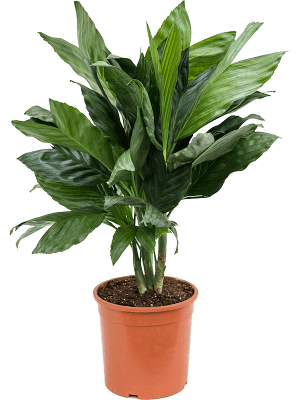
Chamaedorea metallica
Bush
4CHMEBU14
The elegant Chamaedorea is a tropical palm that is easy to care for and requires little light. Most varieties remain relatively small, making it an excellent plant for indoor planting. In this blog, you'll learn all about the origins and care of the Chamaedorea, and we'll tell you more about the different types.
The Chamaedorea belongs to the Arecaceae palm family. This stunning palm originally comes from the tropical rainforests of Central and South America. Here, in its natural environment, the Chamaedorea primarily grows in the shade of taller trees. This ensures the plant has a low light requirement, making it very suitable for rooms with little light.
The Chamaedorea genus has more than 100 species. We will highlight the two most well-known and best-selling species for you.
Chamaedorea elegans: This is probably the most popular species. This plant is also known as the Mexican Dwarf Palm or Mountain Palm. This elegant palm is known for its delicately feathered, fine leaves. The elegans has slightly more demanding care requirements than the metallica.
Chamaedorea metallica: As the name suggests, this species has an almost metallic sheen on its leaves, giving the plant a unique appearance. It is a slower-growing species and can easily be placed in a low light area due to its very dark green leaves.

In terms of light needs, the Chamaedorea elegans and metallica differ. The elegans prefers a bright spot with indirect sunlight. The best place for this palm is right next to a north-facing window. If the Chamaedorea elegans develops yellow leaves, it means the plant is in too bright a location. If the palm does not produce new leaves, it is too dark. The metallica is less demanding about the amount of light and can be placed further away from the window.
The Chamaedorea prefers slightly moist soil. Therefore, water it regularly in small amounts. Prevent the plant's roots from sitting in standing water to avoid root rot. Water again when the top layer of soil is dry; in practice, this means the plant needs more water during the warmer summer months than in the winter months. If young leaves develop brown edges, it usually means the plant is getting too much water. Reduce watering in this case.

It is highly recommended to spray the Chamaedorea regularly. Spraying removes dust from the leaves and makes the plant less susceptible to diseases and pests, such as spider mites.
Because of its tropical origin, the Chamaedorea likes fairly warm temperatures. The minimum daytime temperature is around 18°C. At night, the temperature can drop to about 12°C.
The bottom, oldest leaves of the Chamaedorea will turn brown and die off. A healthy plant will produce new, fresh leaves. Old leaves can be cut off, and brown leaf tips can also be trimmed.
During the growing season (in the spring and summer months), the Chamaedorea can be fertilised by applying universal plant nutrients. Always refer to the packaging for the correct amounts. Outside the growing season, in autumn and winter, the plant does not need any additional nutrients.
